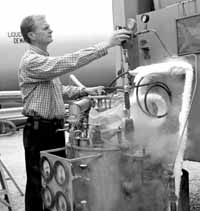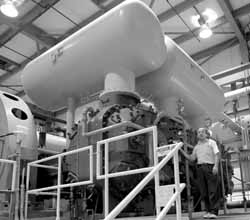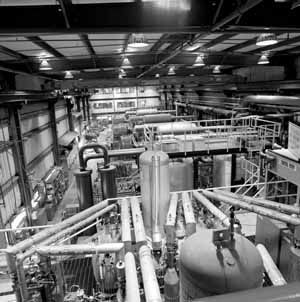 |
|
Keeping it Cool Kurt Riesselmann
Visitors rarely come to the place where Fermilab produces its coolest and arguably most important stuff. Located just opposite the fancy-looking Feynman Computing Center, a plain industrial building labeled CHL hosts a complex arrangement of large and extremely loud machines.
CHL stands for Central Helium Liquefier.
Without the CHL, the Tevatron, the world's most powerful particle accelerator, would have no beams, no collisions and no experiments. Without the people working at the CHL, physicists could forget about finding the Higgs boson at Fermilab.
To keep the Tevatron running, Fermilab operates one of the largest helium plants in the world. It produces liquid helium at 4.5 kelvins (-450 Fahrenheit). Ultracold helium is the perfect coolant to keep the Tevatron magnets at superconducting temperatures, eliminating electrical resistance inside the magnet coils.
Starting from gaseous helium at room temperature, the CHL facility can produce up to 6,300 liters of liquid helium per hour. Using pumps and dewars, special containers to store cold fluids, the CHL can deliver a peak rate of 9,000 liters per hour. More than 25 km (15 miles) of pipes transport helium from the CHL to the Tevatron magnets and back. Four crews totaling 14 people take turns operating the facility 24 hours a day, seven days a week.
"They work 12-hour shifts to maintain the equipment, supervise the controls and carry out emergency repairs," said Mike Geynisman, a mechanical engineer in the Cryogenic Operations group. Aided by a computerized system, the crews tune the CHL performance to produce the right amount of helium, replacing the helium that evaporates while cooling the magnets. Depending on the status of the Tevatron magnets and the status of the particle beams inside, the demand for liquid helium can fluctuate by 30 percent within a short time.
Operations change dramatically when a magnet quenches as it returns to normal-conducting temperatures. Within seconds, the energy of the magnet's strong magnetic field is converted into heat as the magnet regains electrical resistance. The surrounding helium quickly boils off and the magnet warms up even further. An automated system immediately shuts valves and redirects the helium flow. The CHL operators then must carefully monitor the recovery and respond to changing helium demands.
Ideally, Fermilab's helium cooling network is a closed system. In reality, helium is lost due to magnet quenches and tiny leaks. Helium is one of the hardest substances to capture, as proven by billions of birthday balloons that fizzle out or float away before the party ends.
"Some leaks are extremely difficult to stop," said Theilacker. "Many pieces of cryogenic equipment have hundreds of connections." They are all candidates for possible leaks, hard to check and even harder to fix. Even worse, new leaks can develop every time a piece of equipment undergoes a major change in temperature: A 20-foot-long magnet, warming up from 4.5 kelvins to room temperature, expands by almost an inch.
"Even when the Tevatron is not in operation, we usually maintain its magnets at liquid-nitrogen temperature," said Jerry Makara, head of Cryogenic Operations. "It minimizes the stress on the magnets [from heat expansion]. And it is optimal from a cost-benefit point of view."
In addition to the helium system, Fermilab operates a nitrogen cooling system that shields magnets and the liquid-helium transfer line from direct heat exposure. The system, fueled by a nitrogen reliquefier located at the CHL facility, guarantees that the magnets stay below 77 kelvins, the boiling temperature of nitrogen.
The Cryogenic Department has worked continuously to make the cooling system more reliable. One of the present projects includes the upgrade of one of two coldboxes for liquid helium production. It is designed to match the increased helium demand by the Tevatron, which is now operating at an energy about 10 percent higher than four years ago. The new beam energy of 980 GeV requires stronger magnetic fields, resulting in higher cooling demand by the magnets.
"We've been doing upgrades for the last 20 years," said Makara. "As soon as we are done with one project, the next one is in line." With past visionary guidance of physicists Ron Walker and Bill Fowler, the upgrades have greatly improved the availability of liquid helium for the Tevatron. CHL engineers designed and implemented redundancy in the cooling system to make it less prone to equipment failures. At the same time, production capacities were increased to permit faster cool-downs after a magnet heated up.
"Recently, the reliability of our equipment has been 95 percent," Geynisman said. "Due to our storage capacities and backup equipment, liquid helium was available to the Tevatron 99.9 percent of the time."
With its combined knowledge and dedication, the CHL group should be able to keep it cool.
Central Helium Liquefier
At very low temperatures, when other matter is frozen, helium gas becomes liquid. Liquefaction can be achieved through a four-step process of compression, heat exchange, expansion, and subcooling. At Fermilab, helium refrigeration and liquefaction takes place in the CHL facility and in 24 refrigerators round the Tevatron ring.
At the CHL, four independent compressors pressurize helium gas from 0.1 to 1.6 megapascal (1 MPa equals 145 psi). The gas, still at ambient temperature, is filtered to remove impurities that would freeze and clog heat exchangers as the helium is cooled. The CHL filters reduce impurities to less than one part per million.
The liquid helium is either stored in vacuum-insulated dewars, which can hold up to 83,000 liters of liquid helium, or routed to the Tevatron transfer line where, flowing through a subcooler, its temperature drops to 4.8 kelvins.
Six buildings with 24 compressors and 24 refrigerators are located along the Tevatron. With help from the CHL, the refrigerators produce the liquid helium to cool the superconducting magnets inside the Tevatron tunnel. Carefully aligned, the magnets are needed to guide proton and antiproton beams around the four-mile-long ring.
The Tevatron magnets are made of niobium-titanium, a material that becomes superconducting at 10 kelvins (-440†). Below this temperature, the coils of the magnets carry electrical currents without resistance.
The Tevatron magnets are operated at about 4.5 kelvins, making liquid helium the only available coolant. It absorbs heat as it evaporates, keeping the magnets cold and superconducting. The helium gas produced in this process carries away the heat. Warm helium gas is returned to the compressors along the Tevatron ring and further to the CHL to be reprocessed.
Fermilab's cooling system is designed to supply each magnet with enough liquid helium to compensate for losses due to the heat created by electrical currents. Otherwise, the temperature of a magnet will begin to rise. More liquid helium is needed or the magnet will return to its normal-conducting mode. If electrical resistance occurs, more heat will be produced, reinforcing the warm-up process. Eventually the magnet quenches: Within seconds, the energy of the magnetic field completely transforms into heat, evaporating the magnet's entire liquid helium supply. The excess helium gas created in this process can be captured and temporarily stored in tanks until the magnet can be cooled down again.
|
| last modified 10/20/2000 email Fermilab |
FRLsDFx9eyfrPXgV
 "Special teams repeatedly check the Tevatron cooling system for leaks," said Jay Theilacker, head of Fermilab's Cryogenic Department. Using special sprays and portable detectors, the teams have located hundreds of leaks. By fixing the leaks, Fermilab hopes to save some of the one million dollars it spends annually on purchasing liquid helium, one truck-load of 30,000 liters each month.
"Special teams repeatedly check the Tevatron cooling system for leaks," said Jay Theilacker, head of Fermilab's Cryogenic Department. Using special sprays and portable detectors, the teams have located hundreds of leaks. By fixing the leaks, Fermilab hopes to save some of the one million dollars it spends annually on purchasing liquid helium, one truck-load of 30,000 liters each month.

 The pure high-pressure helium gas then enters one of the CHL coldboxes, where it is pre-cooled to 77 kelvins (-320† Fahrenheit) using liquid nitrogen. To lower the temperature further, the coldbox extracts additional energy by guiding the gas through a series of cryogenic turboexpanders and elaborate heat exchangers. In the expanders, the pressurized helium gas spins turbines at 55,000 revolutions per minute. By performing this work, the helium lowers its temperature (conservation of energy). Sending the expanded helium through heat exchangers reduces the temperature of warmer, high-pressure helium. Successive steps repeat the expansion and heat-exchange processes, eventually leading to liquefaction. The final expansion cools the helium to below 6 kelvins at 0.33 MPa.
The pure high-pressure helium gas then enters one of the CHL coldboxes, where it is pre-cooled to 77 kelvins (-320† Fahrenheit) using liquid nitrogen. To lower the temperature further, the coldbox extracts additional energy by guiding the gas through a series of cryogenic turboexpanders and elaborate heat exchangers. In the expanders, the pressurized helium gas spins turbines at 55,000 revolutions per minute. By performing this work, the helium lowers its temperature (conservation of energy). Sending the expanded helium through heat exchangers reduces the temperature of warmer, high-pressure helium. Successive steps repeat the expansion and heat-exchange processes, eventually leading to liquefaction. The final expansion cools the helium to below 6 kelvins at 0.33 MPa.